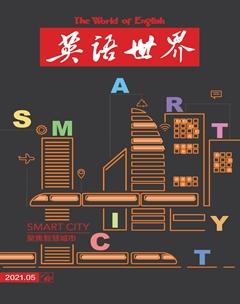A Smart City: More Than Just Tech 智慧城市不止科技
余浩洋 賀鶯
Boston wants to be smarter. The city has taken advantage of tiny sensors, big data and other technologies to become more responsive to its residents needs. But technology alone is not sufficient to make todays cities liveable. Boston has discovered that it also needs to reach the old-fashioned low-tech community and integrate that technology with city life.
Kris Carter, co-chair of the Mayors Office of New Urban Mechanics1, rolled out Bostons smart city program in 2014 with an app that residents could download to report locations where sidewalks needed repair. The city collated2 those reports and ranked them in a database, which repair crews used to prioritize their work.
The system worked beautifully, except for one problem: most of the alerts came from wealthier neighborhoods, where the concentration of smartphone-equipped residents was highest.
Bostons push to become a leading smart city now contains a core tenet3: high-tech initiatives shouldnt disproportionately benefit the already well-resourced. Under Carter, technology is seeping into the citys functioning and daily life, but with a special eye to serving those populations and neighborhoods that need the most support.
Being smart without smartphones
Carters group run meetings in local libraries and other public spaces to find out what problems people in different neighborhoods care about solving.
During the COVID-19 crisis, Boston started a project to use chatbots to help residents access food and provide logistical support. The project is a collaboration with MIT and financed through a resilience fund that the mayor launched at the start of the pandemic. It provides an interface for residents who are homebound or otherwise unable to access any of the meal sites. The chatbots operate in multiple languages, reducing the communications burden and allowing staff to more effectively focus resources on residents who need more personal attention. “We saw this as a good prototype for other engagements that arise for other purposes than food,” said Karter.
For many other issues, Carters group runs small experiments into potential high-tech solutions, which can have surprising results. For instance, they installed benches with built-in solar-powered mobile-phone chargers in three different locations and monitored how they were used. One bench was in the tourist-heavy Boston Commons park4, one at a childrens playground where parents often sat, and one alongside an outdoor basketball court in a low-income neighborhood. When the group examined usage data, it saw that the park charger got a fair amount of use and the playgrounds almost none—whereas the basketball court charger was used almost non-stop. It turned out that players were plugging in small electronic scoreboards, adding to the courts popularity. “The response was off the charts5,” says Carter. “Now the city is looking to add chargers to more neighborhood courts to promote exercise and increase well-being.”
Another experiment involved placing noise and quality-of-air sensors prominently at eye level on streetlights and other poles through a few neighborhoods, labelling them so that residents would be aware of the effort. But most of the sensors were vandalized6. “We had wanted to be transparent about the technology,” says Carter. “But apparently people thought the sensors were weird or annoying.” The city now plans to reinstall them, but at heights of at least 12 feet, without the labels.
Carters group also looks for ways that relatively inexpensive, easily deployable technology can make a difference, especially for the most vulnerable groups. To boost road safety, it released an app that encouraged people to engage in a safe driving competition with other residents, tracking their driving habits in order to name winners. Carter expects that this and similar apps will play a growing role in reducing traffic fatalities, “especially those involving pedestrians and senior citizens.”
However, the city veered away from the higher-tech pathway when it came to dealing with parking spaces. These are in short supply, and drivers looking for an elusive empty space were frequently circling around the block, increasing congestion by as much as 30 percent. At first Carters group experimented with sensors embedded in the road to detect when a space was empty. But the sensors couldnt detect snow—a regular problem in a city where winter storms sometimes bury the streets in several feet of snow—and would mistakenly report snow-filled spaces as empty.
The city then tried installing sensors on parking meters, alerting drivers via an app to newly open spaces, and even enlisting the data to raise parking meter prices during peak-time space crunches7 to encourage drivers to find other transportation or parking options. Eventually, Carters group raised meter prices permanently and uniformly across the city. Not only did awareness of the higher prices lead more drivers to walk, bike or take public transportation, but the extra money was used to improve bus services, which do more for lower-income neighborhoods than parking improvements.
Whether using low-tech or high-tech approaches, says Carter, to stay smart, a city needs to continually reassess its options to spot opportunities to improve residents lives. Take the sidewalk repair program. Walking the streets was proving a useful, if inefficient, way to prioritize repair needs. But last year the group found that pedestrians mobile phones could be anonymously tracked as they moved along the streets, and that data could be analyzed to identify sidewalk routes which are most often used by neighborhoods.
“Combined with our other sidewalk information, that gave us an even better way to predict where faster repairs would do the most good,” says Carter. ■
美國波士頓市擬推進智慧城市建設。該市已利用小型傳感器、大數據等技術手段提升了對市民需求的反應能力。但是單憑技術并不足以確保當今的城市宜居。波士頓市發現,智慧化需要同時惠及技術含量較低的老派社區,并將此類技術與城市生活緊密結合起來。
克里斯·卡特是“波士頓市長辦公室新城市機械師計劃”的聯合主席,他于2014年發布了一款應用程序,就此鋪開了波士頓智慧城市計劃。市民可下載該程序并報送需要維修的人行道位置。市政人員核實收到的信息并在數據庫中進行排序,維修團隊據此確定工作的優先級。
該系統當時運行得順利,只出現一個問題:維修報警信息大都來自富裕社區,原因是這些社區持有智能手機的居民最為集中。
如今,波士頓一流智慧城市建設計劃中包含了一條核心原則:高科技項目不應過度惠及資源充足的人群。在卡特的領導下,技術正逐漸滲透到城市運轉和日常生活中,并對那些最需要幫助的人群和社區給予特殊關注。
智慧化不依賴智能手機
卡特團隊在地方圖書館等公共場所召集會議,了解不同社區民眾希望解決的問題。
新冠肺炎疫情危機期間,波士頓市啟動了一個項目,用聊天機器人幫助市民獲取食品并提供物流支持。該項目與麻省理工學院合作開展,資金來源是波士頓市長在疫情之初設立的抗疫基金。項目給困居家中或因其他原因無法前往用餐地點的居民提供了一種交互入口。聊天機器人可使用多種語言工作,減輕了溝通負擔,讓工作人員可以把資源更有效地集中在更需要人工關注的居民身上。卡特說:“我們認為這是一個很好的樣板,除了幫助提供食品,還有其他用途。”
對于許多其他問題,卡特團隊就可能的高科技解決方案開展小實驗,結果有時會出乎意料。例如,他們在三個不同地點安裝內置太陽能手機充電器的長椅,并監控其使用情況。其中一條長椅放置在游人如織的波士頓公園,一條放置在一個兒童樂園里家長常坐下休息的地方,一條放置在一個低收入社區的戶外籃球場旁邊。研究團隊檢查使用數據時發現,公園充電器使用量相當大,兒童樂園的基本沒用過,而籃球場的充電器幾乎是不停地使用。原來,打球的人把小型電子計分牌插在充電器上,增加了球場的人氣。“這種反應真是好極了。”卡特說,“本市目前正打算給更多的社區籃球場安裝充電器,以鼓勵市民多運動,提升幸福感。”
另一項實驗是在幾個社區的路燈及其他柱子上安裝噪音和空氣質量傳感器,選擇與視線齊高的顯眼位置,并貼上標識,以便居民們能夠注意到。結果是大多數傳感器都被人為破壞了。卡特說:“我們本意是想讓科技手段更透明,但顯然人們認為這些傳感器很奇怪或很煩人。”目前市政府計劃重新安裝傳感器,但高度至少為12英尺,不加標識。
卡特團隊還在尋求方法,讓相對便宜、容易部署的技術發揮作用,尤其是在幫助弱勢群體方面。比如,為提升道路交通安全,團隊發布了一款應用程序,鼓勵市民加入安全駕駛競賽。這款程序能記錄市民的駕駛習慣,據此篩選出獲勝者。卡特預計此類應用程序將會在降低交通死亡人數方面發揮日益重要的作用,“特別是減少行人和老年人的交通死亡”。
不過,在解決停車位的問題上,波士頓市駛離了高科技軌道。市內停車位短缺,駕車人往往繞著社區兜圈子苦尋車位,使擁堵程度增加了30%之多。一開始,卡特團隊在馬路上試裝了傳感器探測空置車位,但是傳感器無法識別積雪——這是波士頓經常出現的一個問題,冬天暴風雪來臨,街道有時被積雪覆蓋數英尺之深——傳感器會把積雪處誤報為空車位。
該市后來又嘗試在停車收費咪表上安裝傳感器,通過應用程序提醒司機注意新空出的車位,甚至在車位緊張的高峰期利用這些數據提高咪表收費標準,以鼓勵駕車人使用其他交通工具或調整停車地點。最終,卡特團隊在全市范圍內統一并永久性地提高了咪表收費標準。意識到停車費用上漲不但促使更多原本駕車的市民選擇步行、騎單車或使用公共交通工具,由此增加的收入還被用于改善公交車服務,對低收入社區而言,這比改善停車條件更有用。
卡特指出,低技術也好,高技術也罷,一個城市要想保持智慧化,就要不斷重新評估其選擇,尋求改善市民生活的機會。以人行道維修項目為例。過去,走街串巷雖然效率不高,但證明是確定道路維修優先級的有效方式。不過團隊去年發現,可以匿名追蹤路上行人的手機信號,通過數據分析確定街區內哪些路段的人行道使用頻率最高。
卡特指出:“結合有關人行道的其他信息,就可以更好地預測優先修繕哪些路段收益最大。”? ? ? ? ? ? ? ? ? ? ? ? ? ? ? ? ? ? ? ? ? □
(譯者單位:寧波大學)
1由美國波士頓政府市長辦公室2010年起設立的機構(簡稱MONUM),致力于吸收民眾力量參與技術創新,打破政府和民眾之間的壁壘,建立政府內部和外部創新者的合作渠道,解決城市發展過程中的新問題。? 2 collate比對,核實。
3 tenet宗旨;原則。
4位于波士頓市中心,是美國最古老的城市公園之一,公園內景觀眾多,也經常用作迎接貴賓的大眾集會場所。? 5 off the charts處于極高水平的。? 6 vandalize故意破壞(他人財物)。
7 crunch(突發的)不足,短缺。

